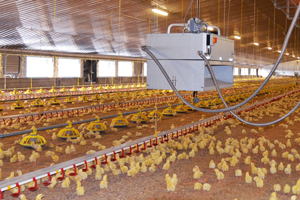UK collaboration develops new broiler shed radiator

One of the UK’s largest independent broiler producers, Alan Simpson Farming, has worked with agricultural ventilation specialists Hydor to develop a new radiator for use with its destratification fans.
It is common knowledge that warm (heated) air rises to the highest point of any enclosed area, thus pushing cooler air down to floor level. To counter this natural effect, maintaining temperatures at floor level has traditionally been achieved by prolonged and continued, if not continuous, heating of the entire space. This generally results in greater fuel consumption and higher costs than is really necessary. Without destratification fans installed in a ventilated poultry building, rising heat collecting in the ceiling void can mean a difference in temperature levels of as much as 5°C.
When the UK Government announced its Renewable Heat Incentive (RHI) – the scheme set up to encourage uptake of renewable heat technologies through the provision of financial incentives – Alan Simpson Farming decided it would take advantage of the initiative. Charles Simpson determined that the farm should use destratification fans to distribute the heat created by the biomass boilers that the company was fitting throughout the fifteen sheds. The farm was already using Hydor’s destratification fans with conventional gas heaters before the move to the biomass boilers and had been pleased with the results. Simpson, though, sought to further improve efficiency through the development of a new radiator.
Before the collaboration between Charles Simpson and Hydor in developing the new radiator, there were two types of radiator being used with the destratification fans – models in stainless steel and aluminium. The stainless steel version was certainly robust but, because of the material from which it is manufactured, naturally came at a high cost. The less expensive aluminium model was also thought to be efficient but prone to damage if not treated carefully by workers when cleaning out the sheds, particularly when using high-powered jet washers. It was the need for the development of a stronger heater that prompted Simpson to approach Hydor for the company’s assistance.
To help find a suitable solution, Charles and Hydor worked with existing contacts within the industry to develop a coil fabricated in steel before being hot dip galvanised to make it more durable before integration into the Hydor heater. Indeed, Charles Simpson believes that the result of the cooperative is so strong and robust that it is the “strongest radiator for the job” available in this country.
Paying for themselves in three years
The biomass boilers for Alan Simpson Farming, of which there were eleven, were shipped in containers in simple, ready-to-install mode. They are all 199 kilowatt rated. Operating on wood pellets, the new boilers will save around 30% of the costs of running the old gas heated boilers. The pellets are a processed form of wood, which although expensive, are more condensed and uniform than the chipped or ground-up waste wood used in other systems. They are generally more efficient. Pellets are stored in a grain type storage silo and moved to the boilers via an auger system. Storage requirements are less for pellet-fired systems which, again, helps keep down costs. The operational savings are in addition to the UK Government’s RHI payment of £22,500 for each boiler.
Although the cost of equipping each shed with the jointly developed, galvanised coil radiators adds about 6% more to the total cost, the long term savings should be significant. The investment by Alan Simpson Farming throughout all its fifteen sheds has amounted to approximately £1.3 million but Charles Simpson strongly believes that this will start showing a very healthy return on investment (ROI) after only three years.
Control is important
In the farm’s seven newest sheds, underfloor heating was originally installed when the buildings themselves were first erected. This too is fed by hot water but is slower to react and achieve the required temperatures than an air blown system.
The installation of destratification fans and their new radiators to supplement the underfloor heating gives the farm greater controllability and faster response whenever unexpected cold snaps cause the need. Contrary to some reports concerning hot water heating systems, Charles Simpson finds the system relatively quick in heating the shed before the birds come in. “We find that the system is now able to lift the temperature of any shed from only 10°C to around 28C° in just six hours or less.”
But he makes the point that control of the fans and heat source is an important and integral part of the system. A three way valve, such as a solenoid valve, is essential to ensure that there is always a supply of some warm air entering each shed, because it can allow a pre-determined percentage of hot water to continue flowing through the system. The speed of the fans can be varied and quite substantially reduced but it’s a good thing to keep the boiler just ticking over – rather than switching it on and off completely. He explains. “You’re saving on the energy used to run the fans – and only providing ventilation depending on the birds’ needs.”
Achieving better levels of performance
Over the last few crops, Charles has noticed a significant improvement in the results achieved in the broiler sheds. “We have already achieved a European Production Efficiency Factor (EPEF) of more than 400 in many of our sheds. This is such a demanding business and we are such a big operation that it would be unrealistic to believe we could achieve this in every shed, all of the time, but we are trying. Our target currently is to achieve an EPEF of 400 or more in at least 75% of the sheds.”













